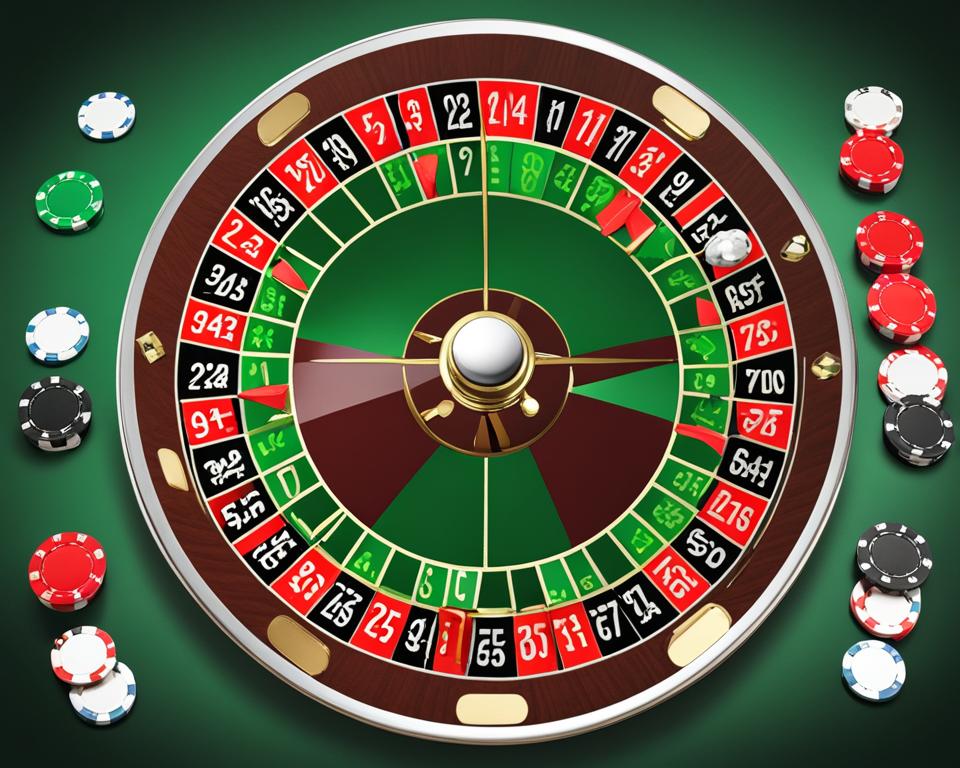Playing online roulette at top internet casinos is a thrilling activity for Canadian gamblers. This guide will explore various betting systems for roulette, different bets and their odds, differences between roulette variants, and the house edge players will face. It will also provide a free roulette chart that explains bets, payouts, and odds, allowing beginners to practice and perfect their strategies.
Key Takeaways:
- Understand different betting systems and choose the one that aligns with your objectives
- Negative progression systems involve increasing the bet after a loss, while positive progression systems require decreasing the bet after a loss
- Consider the advantages and disadvantages of each strategy when selecting the right one
- European Roulette has a lower house edge compared to American Roulette, making it the preferred variant for maximizing chances of winning
- Outside bets have higher odds of winning but offer lower payouts, while inside bets offer higher payouts but have lower odds of winning
Understanding Roulette Strategies
When it comes to playing roulette, beginners often face the challenge of understanding the various strategies available. To make it easier for newcomers to grasp the concept, there are beginner-friendly roulette strategy charts and easy-to-understand roulette charts that can be utilized. These charts provide a visual representation of different betting systems, making it easier for beginners to comprehend and implement effective roulette strategies.
There are several roulette strategies that are particularly effective for beginners. Negative progression systems, such as the Martingale, D’Alembert, Fibonacci, and Labouchere, involve increasing bets after a loss. These strategies aim to recoup losses and generate profits when a winning bet finally occurs. On the other hand, positive progression systems like the 1-3-2-6, Contra D’Alembert, Reverse Labouchere, and Paroli involve increasing bets after a win, allowing beginners to capitalize on winning streaks.
Each roulette strategy has its own unique strengths and weaknesses. For example, negative progression systems offer the potential for large winnings but require a substantial bankroll to withstand potential losing streaks. Positive progression systems, on the other hand, are less risky but may yield smaller profits. It’s crucial for beginners to review these strategies and choose the one that aligns with their goals and risk tolerance.
Here are key roulette strategy tips for newcomers to keep in mind:
- Understand the rules and mechanics of different roulette strategies to make informed decisions.
- Practice using beginner-friendly roulette strategy charts to improve familiarity and decision-making skills.
- Consider your risk tolerance and objectives when choosing between negative and positive progression strategies.
- Adjust and adapt strategies to suit individual preferences and playing styles.
Quote:
“Becoming familiar with beginner-friendly roulette strategy charts is an excellent way for newcomers to approach the game with confidence and increase their odds of winning.” – Casino Expert
By gaining a comprehensive understanding of different roulette strategies and utilizing the available resources such as beginner-friendly roulette strategy charts, beginners can enhance their gaming experience and improve their chances of success at the roulette table.
| Roulette Strategy | Progression Type | Strengths | Weaknesses |
|---|---|---|---|
| Martingale | Negative | Potential for large wins | Requires a large bankroll |
| D’Alembert | Negative | Gradual progression, less risky | Smaller profits |
| Fibonacci | Negative | Structured betting sequence | May not withstand long losing streaks |
| Labouchere | Negative | Potential for customizable progression | Requires careful planning |
| 1-3-2-6 | Positive | Opportunity for larger wins | Enduring losing streaks can lead to losses |
| Contra D’Alembert | Positive | Gradual progression, less risky | Smaller profits |
| Reverse Labouchere | Positive | Customizable progression | May require careful planning |
| Paroli | Positive | Opportunity for larger wins | Potential for quick losses |
Negative Progression Systems
In the world of roulette betting strategies, negative progression systems play a crucial role. These systems involve increasing the bet after a loss and decreasing it after a win. Let’s take a closer look at some popular negative progression strategies: the Martingale, D’Alembert, Fibonacci, and Labouchere.
The Martingale strategy is perhaps the most well-known negative progression system. It’s straightforward: after each loss, the player doubles their bet in hopes of recovering losses with a single win. However, this strategy can be risky, as it requires a substantial bankroll to sustain consistently doubling bets.
The D’Alembert strategy takes a more moderate approach by increasing the bet by one unit after a loss and decreasing it by one unit after a win. This system provides a more gradual progression and can be suitable for players who prefer a balanced betting approach.
The Fibonacci strategy relies on the famous Fibonacci sequence, where each subsequent number is the sum of the previous two numbers (e.g., 1, 1, 2, 3, 5, 8, and so on). In this strategy, players increase their bet based on the Fibonacci sequence, aiming to recover losses with a winning bet.
The Labouchere strategy, also known as the cancellation system, involves creating a series of numbers that sum up to the desired profit goal. Players place bets corresponding to the sum of the first and last numbers in the series, crossing them off as they win. If a bet is lost, the player adds the lost amount to the end of the series. This strategy allows for more flexibility and customization based on individual profit goals.
It’s important to note that while negative progression systems can be enticing, they don’t guarantee winning outcomes. They are designed to manage losses by increasing bets, but they also come with inherent risks that players should be aware of.
Comparison of Negative Progression Systems
| Strategy | Description |
|---|---|
| Martingale | Doubles the bet after each loss |
| D’Alembert | Increases the bet by one unit after a loss |
| Fibonacci | Uses a sequence of numbers to determine the bet amount |
| Labouchere | Bases the bet progression on a series of numbers that sum up to the desired profit goal |
Positive Progression Systems
Positive progression systems are a popular choice among roulette players as they involve increasing bets after a win, allowing for the potential of maximizing winnings. These strategies offer a different approach compared to negative progression systems, providing an opportunity for players to take advantage of winning streaks. Here are four positive progression systems commonly used by roulette enthusiasts:
1-3-2-6 Strategy
The 1-3-2-6 strategy is a simple and straightforward positive progression system. As the name suggests, the strategy follows a specific number sequence where the bet is increased after each win. The system starts with a base bet and progresses by multiplying the initial bet by each number in the sequence. After four consecutive wins, the system restarts.
Contra D’Alembert Strategy
The Contra D’Alembert strategy is an inverse version of the well-known D’Alembert strategy. With this system, players increase their bet by one unit after a win and decrease it by one unit after a loss. The Contra D’Alembert strategy aims to take advantage of winning streaks while minimizing potential losses.
Reverse Labouchere Strategy
The Reverse Labouchere strategy is a variation of the Labouchere strategy, which is a negative progression system. In this positive progression system, players create their own number series and increase their bet after a win. The Reverse Labouchere strategy allows players to maintain a structured betting system while capitalizing on winning streaks.
Paroli Strategy
The Paroli strategy is a popular positive progression system that focuses on doubling the bet after three consecutive wins. This system aims to capitalize on winning streaks and maximize profits. However, it’s important to exercise caution as a loss after the winning streak would reset the bet to the base amount.
It’s essential for players to understand the strengths and weaknesses of each positive progression system and choose the one that aligns with their gameplay style and objectives. By utilizing these strategies effectively, players can enhance their roulette experience and potentially increase their chances of winning.
Selecting the Right Strategy
When it comes to choosing a roulette strategy, it’s crucial for players to carefully evaluate the advantages and disadvantages of each system. Understanding different betting systems and the potential odds they offer is essential for maximizing the chances of success at the roulette table.
There are several types of betting systems available, each with its own unique characteristics and outcomes. Negative progression systems, such as the Martingale strategy, provide the potential for profit even with more losses than wins. However, they come with the risk of hitting table limits or personal limits quickly. Positive progression systems, on the other hand, like the Paroli strategy, can’t survive losing streaks but offer higher potential payouts during winning streaks. Finally, stable bet progression systems provide a more consistent approach, but they may fail under longer losing streaks or unfavorable luck.
Players should select a strategy that aligns with their risk tolerance and desired goals. Consider your personal preferences and the level of risk you are comfortable with. Are you willing to take higher risks in exchange for the possibility of larger payouts? Or do you prefer a more conservative approach that provides a steadier stream of smaller wins?
Remember, there is no one-size-fits-all strategy for roulette. What works for one player may not work for another. It’s important to assess your own objectives and playing style to find the strategy that best suits you.
Comparing Roulette Strategies
| Strategy | Advantages | Disadvantages |
|---|---|---|
| Negative Progression | – Offers potential profits despite more losses – Can be effective in shorter sessions |
– High risk of reaching table or personal limits quickly – Doesn’t guarantee long-term success |
| Positive Progression | – Allows for higher potential payouts during winning streaks – Provides a controlled betting approach |
– May not survive losing streaks – Moderate risk of larger losses |
| Stable Bet Progression | – Offers a more consistent approach – Minimizes potential rapid losses |
– Can fail under extended losing streaks or bad luck – Lower potential for large wins |
By carefully weighing the pros and cons of each strategy, players can make an informed decision and choose the roulette strategy that best suits their individual needs. Keep in mind that understanding the betting systems and their potential outcomes is key to maximizing your odds and enjoying a successful roulette experience.
Next, we will explore the different variations of roulette and how they can impact your odds of winning. Understanding the differences between European Roulette, American Roulette, and French Roulette is crucial for making informed decisions at the wheel.
Knowing the Variants
The choice of which roulette variant to play can significantly affect a player’s odds of winning.
European Roulette is preferred over American Roulette because it has a lower house edge.
The difference lies in the number of zeros on the wheel, with European Roulette having only one zero compared to two zeros in American Roulette.
French Roulette, with its special rules for even-money bets, further reduces the house edge to 1.35%.
Players should opt for European Roulette whenever possible to maximize their chances of winning.
Comparison of Roulette Variants
| Roulette Variant | Number of Zeros | House Edge |
|---|---|---|
| European Roulette | 1 | 2.70% |
| American Roulette | 2 | 5.26% |
| French Roulette | 1 | 1.35% |
Playing the Outside Bets
In roulette, outside bets offer higher odds of winning but come with lower payouts. These bets cover a wider range of numbers on the wheel, increasing the chances of a win. Popular outside bets include Columns or Dozens, Red/Black, Even/Odd, and Low 18/High 18.
The Columns or Dozens bet is a popular choice, with a payout of 2:1. This bet covers a third of the numbers on the wheel, allowing players to hedge their bets and increase their chances of winning.
Red/Black, Even/Odd, and Low 18/High 18 are even-money bets that cover almost half of the numbers on the wheel. These bets offer a payout of 1:1, making them a safer option for beginners or players looking for a more consistent return.
Many roulette systems and strategies focus on these outside bets to minimize losses and increase the chances of winning. By strategically placing bets on these options, players can develop a more balanced and calculated approach to the game.
Outside bets in roulette offer higher odds of winning but come with lower payouts. By understanding the various outside bet options and incorporating them into their strategy, players can enhance their overall roulette experience.
Here is a visual representation of the different outside bets in roulette:
| Bet Type | Description | Payout |
|---|---|---|
| Columns or Dozens | Covers a third of the numbers on the wheel | 2:1 |
| Red/Black | Covers all red or black numbers | 1:1 |
| Even/Odd | Covers all even or odd numbers | 1:1 |
| Low 18/High 18 | Covers numbers 1-18 or 19-36 | 1:1 |
By incorporating outside bets into their roulette strategy, players can increase their chances of winning and enjoy a more balanced approach to the game.

Playing the Inside Bets
Inside bets in roulette offer the allure of higher payouts, but they also come with lower odds of winning. It’s important for players to understand the different types of inside bets and approach them with caution, especially if they are new to the game.
Straight-Up Bets
One of the riskiest inside bets is the straight-up bet, where players wager on a single number. While the payout for a straight-up bet is 35:1, the odds of hitting the chosen number are significantly lower.
Split Bets
A split bet involves wagering on two adjacent numbers on the roulette table. This type of bet offers a higher chance of winning compared to a straight-up bet, as it covers two numbers. However, the payout is reduced to 17:1.
Street Bets
In a street bet, players place their chips on a row of three numbers in a horizontal line on the table. The odds of winning increase compared to a straight-up or split bet, but the payout decreases to 11:1.
Corner Bets
A corner bet, also known as a square bet, allows players to wager on four numbers forming a square on the betting layout. The payout for a corner bet is 8:1, providing players with more opportunities to win.
While inside bets can offer the potential for bigger wins, they also carry higher risks. As a beginner, it’s advisable to understand the odds associated with each inside bet and make informed decisions. Now that you have learned about inside bets, let’s move on to explore some helpful tips for implementing roulette strategies effectively.
Tips for Roulette Strategy
To maximize the effectiveness of their roulette strategy, beginners should keep the following tips in mind:
- Choose European Roulette: When playing roulette, opt for European Roulette over American Roulette. European Roulette has a lower house edge due to its single zero, which gives players better odds of winning.
- Understand the game’s rules and variations: Familiarize yourself with the rules and variations of roulette. This knowledge will help you make informed decisions and adapt your strategy accordingly.
- Take advantage of casino bonuses: Many online casinos offer bonuses to attract and retain players. Take advantage of these bonuses to increase your bankroll and extend your playing time.
- Manage your losses: It’s important to have realistic expectations and accept that losses are a natural part of gambling. Avoid chasing losses, as this can lead to impulsive decision-making and further losses. Instead, set a budget and stick to it.
By having a clear understanding of the game, choosing European Roulette, taking advantage of bonuses, and managing losses, beginners can improve their chances of winning at roulette and make their gambling experience more enjoyable.

Bonuses: Make the Most of Casino Offers
Casino bonuses can significantly enhance your roulette playing experience. It’s essential to understand the different types of bonuses available and their terms and conditions. Here are some popular casino bonuses:
| Bonus Type | Description |
|---|---|
| Welcome Bonus | A bonus offered to new players upon signing up. It may include a match deposit bonus, free spins, or both. |
| No Deposit Bonus | A bonus awarded to players without requiring a deposit. It allows you to play roulette for free and potentially win real money. |
| Reload Bonus | A bonus offered to existing players when they make further deposits into their casino account. It helps boost your bankroll for more roulette action. |
| Cashback Bonus | A bonus that refunds a percentage of your losses over a specific period. It gives you a second chance if luck hasn’t been on your side. |
| Refer-a-Friend Bonus | A bonus awarded when you refer a friend to the casino and they sign up and deposit. It’s a win-win for both you and your friend. |
Strategies to Avoid
While there are various roulette strategies available, it’s essential to be cautious and avoid strategies that are ineffective or based on flawed logic. Instead, players should focus on strategies that are grounded in sound mathematical principles and offer a realistic chance of success.
Biased Roulette Wheels
One common strategy that players should steer clear of is finding biased roulette wheels. The belief behind this strategy is that certain roulette wheels can favor specific numbers or sections, leading to a higher probability of winning. However, it’s important to note that modern roulette wheels are carefully designed and tested to ensure fairness. The notion of biased wheels is largely a misconception and has no reliable basis in reality.
Dealer Signatures
Another strategy to avoid is looking for dealer signatures. This theory suggests that some dealers may develop a consistent pattern or technique when spinning the roulette wheel, which can be exploited to predict the outcome of the game. However, the idea of dealer signatures is based on conjecture and has no substantial evidence to support its effectiveness. Roulette outcomes are determined by random chance and cannot be reliably predicted based on individual dealer behavior.
Defective RNGs
Exploiting defective Random Number Generators (RNGs) is another strategy that should be avoided. RNGs are sophisticated algorithms that ensure the randomness and fairness of online roulette games. While it’s theoretically possible for RNGs to be flawed, reputable online casinos employ state-of-the-art technology and rigorous testing to prevent any defects. Players should trust the integrity and fairness of the RNGs used in licensed and regulated online casinos.
By disregarding roulette strategies that rely on biased wheels, dealer signatures, or defective RNGs, players can focus on more reliable and mathematically sound strategies. It is crucial to approach roulette with a realistic mindset, understanding that the game’s outcome is primarily determined by chance. Employing strategies that emphasize responsible bankroll management and informed decision-making can ultimately increase the enjoyment and potential for success in roulette.
seowriting.ai
Conclusion
In conclusion, roulette strategy charts can be valuable resources for beginner players who are aiming to enhance their odds at the roulette wheel. By familiarizing themselves with different betting systems, carefully selecting an appropriate strategy, considering the various roulette variants available, and practicing responsible bankroll management, beginners can increase their chances of winning in this exciting casino game.
However, it is crucial to remember that while strategies can improve the odds of winning, there is no foolproof way to guarantee consistent wins in roulette. Players must approach the game with a realistic mindset, understanding that luck and chance play significant roles. Rather than solely focusing on the outcome, players should savor the thrill and enjoyment that roulette provides.
So, whether you decide to adopt a negative or positive progression system, or prefer stable bet progression strategies, always keep in mind that roulette should be embraced as a form of entertainment. Appreciate the anticipation and excitement that each spin brings while employing a well-thought-out strategy to enhance your overall roulette experience.
FAQ
What is the purpose of a roulette strategy chart?
A roulette strategy chart helps beginners understand different betting systems, select the right strategy, and improve their odds of winning at the wheel.
Are there any beginner-friendly roulette strategy charts available?
Yes, there are easy-to-understand roulette strategy charts specifically designed for beginners to learn and implement effective strategies.
What are some popular negative progression systems in roulette?
Negative progression systems in roulette include the Martingale, D’Alembert, Fibonacci, and Labouchere strategies.
Can you explain positive progression systems in roulette?
Positive progression systems in roulette involve decreasing the bet after a loss and increasing it after a win, such as the 1-3-2-6, Contra D’Alembert, Reverse Labouchere, and Paroli strategies.
How do I choose the right roulette strategy for me?
It’s important to consider the strengths and weaknesses of each strategy and choose one that aligns with your goals and risk tolerance.
What are the differences between European Roulette, American Roulette, and French Roulette?
European Roulette has a lower house edge than American Roulette due to having only one zero. French Roulette further reduces the house edge with special rules for even-money bets.
What are outside bets in roulette?
Outside bets in roulette offer higher odds of winning but lower payouts. They include bets on columns or dozens, red/black, even/odd, and low 18/high 18.
What are inside bets in roulette?
Inside bets in roulette offer higher payouts but have lower odds of winning. They include straight-up bets on a single number, split bets on two adjacent numbers, street bets on three numbers in a row, and corner bets on four numbers in a square formation.
Do you have any tips for implementing a roulette strategy?
Tips for roulette strategy include choosing European Roulette for better odds, understanding the game’s rules and variations, taking advantage of casino bonuses, and managing losses responsibly.
Are there any roulette strategies that should be avoided?
Strategies like finding biased roulette wheels, looking for dealer signatures, and exploiting defective RNGs are not reliable methods for winning in roulette.





